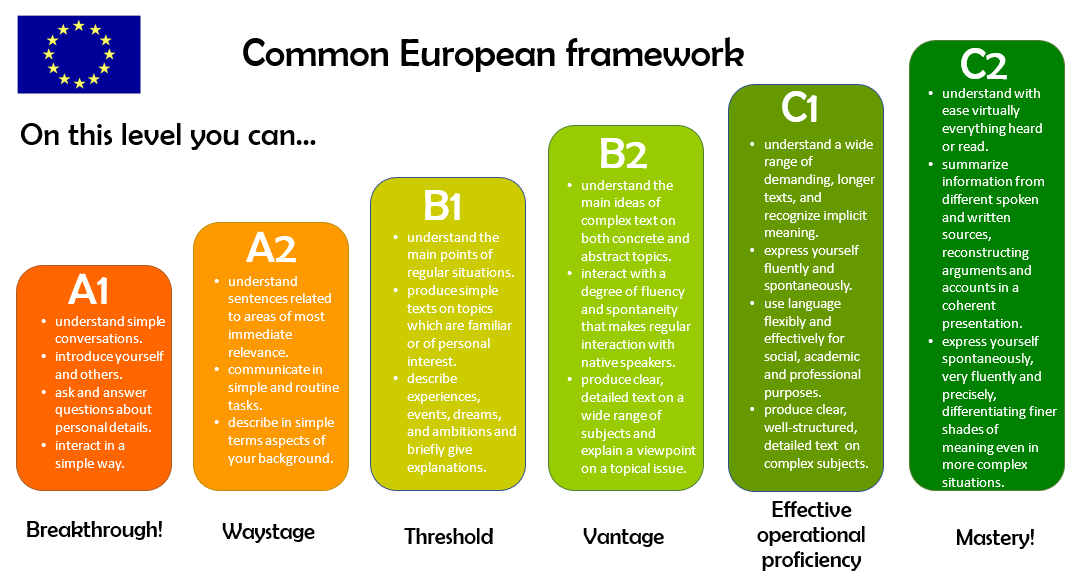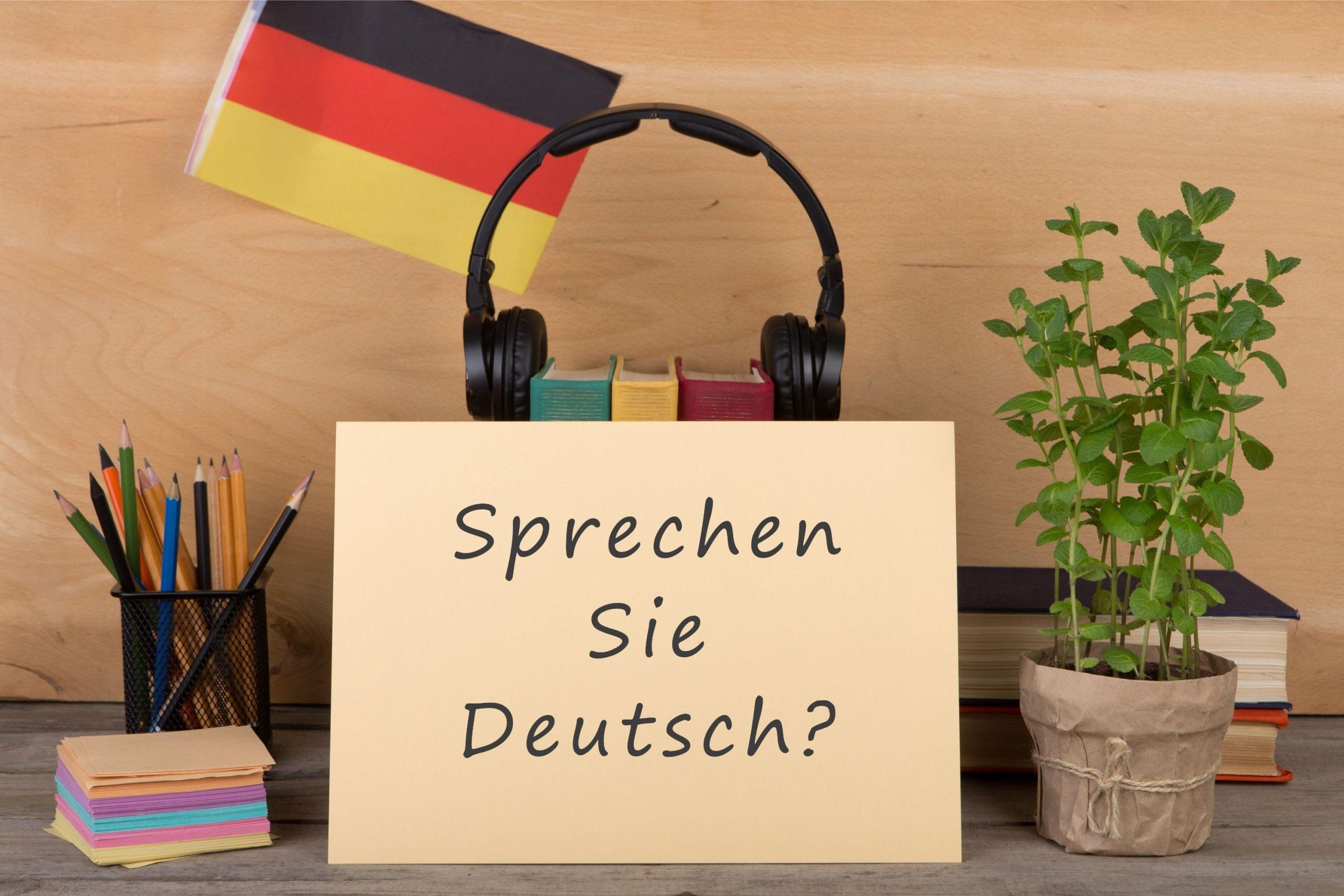
The German Language Levels
Whenever you come across a discussion about learning a foreign language, you usually hear people referring to language levels with letters and numbers (A1, A2, B1, B2, C1 and C2).
In this guide, I’ll walk you through each language level and explain how long you might need to reach it.
CEFR Levels and the Common European Framework
Every letter and number combo is a CEFR level that describes your language ability. CEFR is short for the “Common European Reference Framework”, which is a system used in Europe to make language learning and assessment easier.
If you’re wondering how long learning German will take you, understanding the German levels defined by the Common European Framework of Reference for Languages is crucial. Knowing your current CEFR level is the first step to figuring out how much resources and time you will need to snag that job opportunity with a certain CEFR level as a requirement.
So let’s start with the basic question:
How many German language levels are there?
The German language has 6 CEFR levels – starting with A1 (absolute beginner), and ending with C2 (completely fluent). Let’s look at each level in detail.
The A Levels: Beginners A1
At this level you will be able to use everyday expressions and form simple sentences that are related to concrete needs or routine situations encountered in everyday life (like asking for water).
You will also be able to introduce yourself with very simple sentences, state where you come from and ask other people for similar information.
You can comprehend what other people are saying at this level as long as they speak slowly and use simple words.
A2
At the A2 level you begin understanding frequently used expressions that are related to a wider variety of topics as long as they are of immediate importance (like work, the environment around you
and shopping). Communicating in routine everyday situations and exchanging familiar information will also be easier at this level.
A2 German speakers can describe their origin, education and other common attributes about their person or their past.
A Levels: Recap
These first two German language levels are very elementary, and they’re the bare minimum needed for communication.
So, having covered the A levels means you have some basic knowledge and are capable of having a simple and direct exchange on topics of personal interest when the other speaker speaks slowly and clearly.
Reaching the A1 level (from a point of no previous knowledge of a particular language) has been estimated to take between 60 – 80 hours of instruction by both Deutsche Welle and Alliance Française.
Smarter German offers exactly that with the A1 Beginner’s German and A2 Elementary German Courses.
The B Levels: Independent Language Use – B1
B1 German speakers have no problem understanding the main points of a conversation when clear standard German is used, especially on familiar topics like school or work. If you reach this level, you can rest assured that you can handle most of the travel situations and standard language you will face if you go to a German-speaking country.
At B1, you will be able to have a normal conversation and talk about your interests and areas of expertise. B1 speakers can talk about the past, describe their day and their dreams, make plans and explain familiar topics.
B2
At this upper-intermediate level, you will have a very good command of German grammar and will start understanding the main ideas in complex texts involving both concrete and abstract topics.
Beyond reading comprehension, at B2 you will have the ability to easily discuss topics, give a coherent presentation and summarize information.
B2 speakers can carry fluent conversations with native speakers with neither side having to speak slowly or use simple words.
If you reach B2, you will be able to express yourself in detail, describe dreams and plans, give your opinions on complex situations, and discuss the fine nuances of different options.
B Levels: Recap
The B levels in the German language are when you really start to use the language independently. The Foreign Service Institute (FSI) suggests that you need about 750 hours to get to the B2 level.
Don’t let that number scare you, because Smarter German has made reaching these levels easier than ever with two powerful courses:
The first one is designed to get you there as fast as possible by focusing on the B1 exam (B1 Exam Preparation)
The second one will help you elevate your German speaking abilities to the next level with maximum effectiveness (B2 Upper-Intermediate German).
The C Levels: Fluency – C1
At this point, you will be able to understand a wide range of complex texts with demanding concepts and implicit meanings. C1 speakers almost never need to search for a simple word to express their ideas when they speak German.
At C1, you will be able to use the language effectively in your social, academic, and professional life. You will also be able to express your thoughts eloquently and use different ways to link ideas together appropriately.
C2
The last of the German language levels means that you can understand basically anything you read or hear. You will have the ability to summarize long texts and condense complex ideas in order to explain them to other people.
C2 speakers express their thoughts in a very precise and detailed manner with finer nuances, use idiomatic expressions, and discuss complex topics with the language a native German speaker would use.
C Levels: Recap
The C levels are as competent as you can get in German. How long you’re gonna need to get there depends on how often you use the language. The Goethe Institut says you need to have studied German for at least 750 hours to get to this point. But realistically, it might take you up to 3 years to reach the C2 level.
Even native Germans struggle with reaching this level but with enough practice, you will definitely arrive at your German-speaking goals. Smarter German offers you the C1 Advanced German Course that will make reaching the C1 level infinitely easier.
How do I know which level I’m at?
You might have this question on your mind if you’re already learning German. The above table can give a rough idea of where you fit among the 6 language levels, but the most accurate way to assess your level is by taking an exam.
The TestDaF (Test Deutsch auf Fremdsprache) corresponds loosely to the CERF levels of B2 and C1, as the test is meant to tell whether a student has the language skills needed for academic study in Germany. Meanwhile, the Goethe-Institut has adapted their certificates and levels to match the CERF levels.
With all the different levels and assessments involved, German has a bad reputation for being difficult. But with the way we teach German in my Everyday German Course, you will rediscover the joy of learning a new language.
If you have any questions on any of the German language levels, let me know in the comments below.
FAQs: German language skills and levels
Here, you will find answers to common questions regarding language learning levels.
What level of German is considered fluent?
Achieving fluency in German is typically associated with the C1 level on the international standard of the Common European Framework of Reference for Languages (CEFR).
What level of German language is required to study at a German University?
The required level of German proficiency to study at a German university often falls within the B2 to C1 range of the CEFR. Some universities may conduct a placement test or ask for the TestDaF exam certificate.
Summing Up: The German Language Levels
Embarking on a journey to master the German language involves progressing through six CEFR levels, from A1 beginners to C2 fluency. Each stage offers unique challenges and skills, demanding dedication and effective learning strategies.
Take the leap, embrace the linguistic adventure, and let Smarter German be your guide to achieving proficiency in the German language.

